BHUTAN
History

History
History
Early History and Middle Ages
Archaeological finds so far indicate that the first inhabitants of the low lying valleys in Bhutan between 2000-1500 BC. were nomadic shephards, using the Manas Chhu Valley as a trade route between India and Tibet. Some of Bhutan's first inhabitants were followers of Bon, an animist religion quite common in this part of the Himalayas before the advent of Buddhism. Bon is believed to have been in the 6th century AD. was introduced in Bhutan and Buddhism in the 2nd century, although most historians agree that the first Buddhist temples, including Kyichu Llakhang near Paro and Jampey Llakhang in Bumthang, were built in the 7th century, under the Tibetan King Songtsen Gampo. During the first centuries AD, much of the source material was lost by fires in the 19th century and 1907, and by the earthquake of 1897.
Guru Rinpoche (aka Padmasambhava), is one of the most important Bhutanese historical, mythical and religious figures, as his visit to Bumthang in 746 is widely regarded as the real introduction of Buddhism to Bhutan. Guru Rinpoche was invited by the king of Bumthang to expel evil spirits from his land, among other things. In return, the king and many others converted to Buddhism. Guru Rinpoche is also said to have visited present-day Bhutan during the reign of Muthri Tsenpo (764-817), the son of the 38th Tibetan king Trisong Detsen (742-ca. 800).
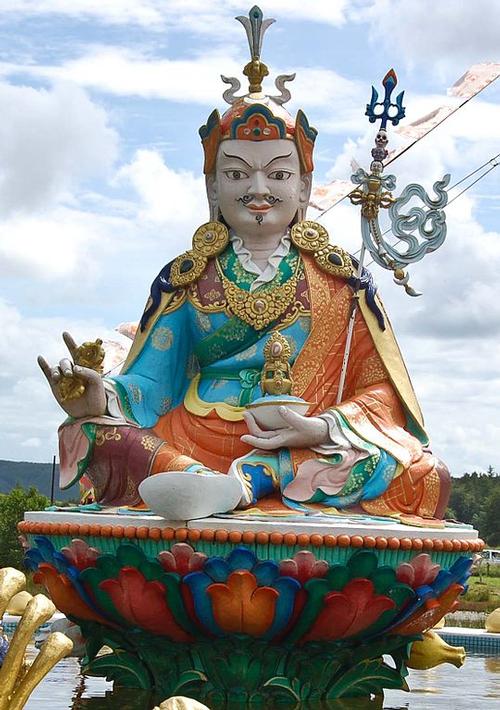 Guru Rinpoche, founder of Tantric BuddhismPhoto: Secretlondon CC 3.0 Unported no changes made
Guru Rinpoche, founder of Tantric BuddhismPhoto: Secretlondon CC 3.0 Unported no changes made
Trisong Detsen's grandson, Langdharma, ruled Tibet from 836 to 842. He was a devotee of the Bon religion, banned Buddhism, destroyed many religious buildings, and exiled his brother, Prince Tsangma, to Bhutan. Many Buddhist monks from Tibet would have fled to Bhutan along with Tsangma. Not long after, Langdharma was assassinated and Buddhism reintroduced in Tibet. The country was in chaos and even now many Tibetans fled to Bhutan.
At the time, there was no central authority in the territory of present-day Bhutan. Instead, several fiefdoms sprang up from the early 9th century, the most prominent of which was the Bumthang kingdom. Tibetan monks who had fled had anchored religiously and culturally in Bhutan. At the time, the fertile valleys of Bhutan were slowly but surely occupied by Tibetan-Mongol military; in the 11th century, all of Bhutan was occupied by these armies. As early as the 10th century, Bhutan's political development has been heavily influenced by its religious history. After a period in Tibet when Buddhism was again threatened, many disputes arose between various subdivisions, which were protected by the Mongol overlords until the 14th century. At the time, the Gelugpa or Yellow Hat school of Tibetan Buddhism, founded by Je Tsongkhapa (1357-1419), after an anarchist period in Tibet, was so prevalent that many Tibetan monks fled from subdivisions to Bhutan.
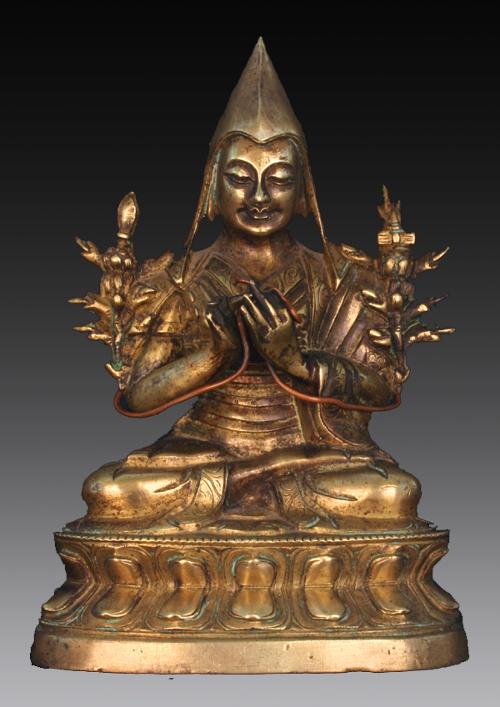 Je Tsongkhapa, founder of the Gelug School of Tibetan BuddhismPhoto: Tibetan Museum Society CC 2.5 Generic no changes made
Je Tsongkhapa, founder of the Gelug School of Tibetan BuddhismPhoto: Tibetan Museum Society CC 2.5 Generic no changes made
Among these monks, the founder of the Lhapa Kagyu School, Gyalwa Lhanangpa, a subsection of the Kagyu School, today one of the six main schools of Himalayan-Tibetan Buddhism. The Lhapa were the founders of a number of strategically located 'dzongs', fortified monasteries. Although the Lhapa subsection was pressured in the 12th century by the Drukpa Kagyu school of Ralung in Tibet, another subsection led by the Tibetan monk lama Phajo Drugom Shigpo (1184-1251), it continued to convert people until the 17th -century. Lama Gyalwa Lhanangpa was defeated by lama Phajo Drugom Shigpo and the latter is widely regarded as the great man behind the development of the Bhutanese form of Buddhism by converting many Bhutans to the Drukpa Kagyu school.
However, between the 12th and 17th centuries, the two schools remained hostile to each other. During this period, Bhutan was often visited by important Druk Kagyu teachers from Ralung, including Lama Ngawang Chhogyel (1465-1540) and his sons, who built various monasteries and temples, including Druk Choeder in Paro and Pangri Zampa and Hongtsho Goemba nearby from the capital Thimphu. Another notable and important Druk Kagyu teacher was Drukpa Kunley (1455-1529), who is still highly prized by the Bhutans and associated with the beautifultemple of Chimi Lhakhang.
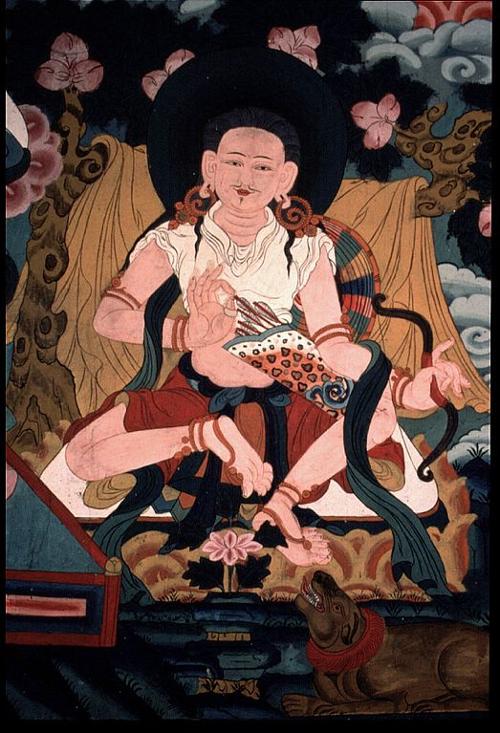 Drukpa Kunley, important Drukpa teacher in BhutanPhoto: Public domain
Drukpa Kunley, important Drukpa teacher in BhutanPhoto: Public domain
In the 16th century, the political arena in Bhutan was still very fragmented, local rulers each controlled a piece of Bhutan and fought many conflicts with other local rulers. Many monasteries vied for superiority, and Western Bhutan lamas tried to extend their influence to Eastern Bhutan.
This situation changed radically from 1616, when Lama Ngawang Namgyal (1594-1651) traveled from Ralung to Bhutan. He is said to be a reincarnation of the founder of Ralung Monastery, Tsangpa Gyarey. However, this was disputed by a ruler from another principality in Tibet, and Ngawang Namgyal more or less fled to Bhutan. On his journey through Western Bhutan he also strengthened his political strength and soon became widely regarded as the religious leader of Bhutan with the title Zhabdrung Rinpoche. Under his rule the 'dzongs' became buildings with a civil, religious and military function; the first dzong built in this way was that of Simtokha, just outside the capital Timphu.
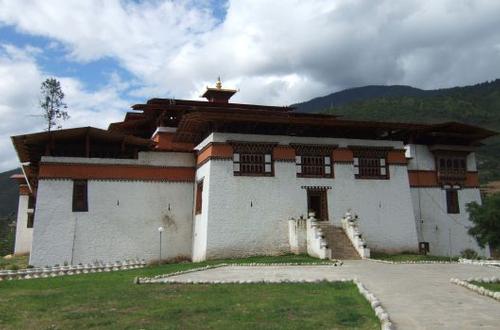 Simtokha Dzong, BhutanPhoto: Christopher J. Fynn CC 3.0 Unported no changes made
Simtokha Dzong, BhutanPhoto: Christopher J. Fynn CC 3.0 Unported no changes made
Ngawang Namgyal was soon fought by a coalition of five lamas led by Lama Palden and in 1629 the Simtokha-dzong was attacked. This attack was repulsed, but the coalition reinforced there with a group of Tibetans and continued to oppose Ngawang Namgyal. But in the end he won the battle, the Tibetans were defeated several times, finally after an alliance with King Singye Namgyal of Ladakh. In 1639 Tibet recognized Ngawang Namgyal as the only real authority in all of Bhutan. He immediately strengthened his power by establishing friendly relations with Rama Shah, the king of Nepal, and with Raja Padmanarayan of Cooch Behar in India. The king of Ladakh also allowed Ngawang Namgyal to settle in a number of places in Tibet for the purpose of meditation and worship, including on the slopes of the sacred mountain Kailash. This situation continued until Tibet was taken over by China in 1959.
Meanwhile, in Tibet, a battle was raging between the Buddhists of Nyingmapa ("red hat") and Gelugpa ("yellow hat"), led by the Dalai Lama. The Dalai Lama was supported by the Mongol leader Gushri Khan, who invaded the Tibetan Tsang province, as the Ringpong dynasty was replaced by the Gelugpa lineage. In 1644 the Mongols and Tibetans attacked Bhutan, but couldn't cope with the heat and the many forests in Bhutan. Ngawang Namgyal himself led the resistance and managed to hold out. To prevent another such invasion and as a memorial monument, the Drukyel Dzong was built at the beginning of the Paro Valley in 1647. Several years later, in 1648 and 1649, one of the most powerful Dalai Lamas ever in Tibet, called "the Great Fifth," again attempted to break the power of Ngawang Namgyal, but every attempt failed miserably. These successes cemented Ngawang Namgyal's power and his excellent army gave him control over the entire country. Minyur Tenpa, appointed by Ngawang Namgyal as governor of the Trongsa region, took action to unite all the valleys of central and eastern Bhutan under the rule of the Ngawang Namgyal. These actions were completed in 1655, while many dzongs were built at the same time. The first Western visitors to Bhutan also arrived in 1627, Portuguese Jesuit missionaries and explorers Estêvão Cacella (1585-1630) and João Cabral (1599-1669), who traveled from Calcutta in India to Shigatse in Tibet. They spent a month in Cheri Goemba, north of Thimphu, near the Zhabdrung. Ngawang Namgyal had established a dual system of government in his day, consisting of a religious leader, the Je Khenpo, and a civil leader, the Druk Desi.
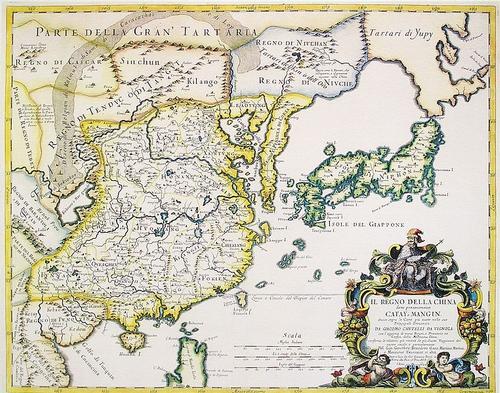
Ngawang Namgyal died in 1651, but to avoid unrest and chaos his death was concealed for nearly 50 years. He was succeeded in 1651 by his minor son and in 1680 by his half-brother, who was also a minor. They were under the control of the Druk Desi and the powerful Je Khenpo into the 21st century. During that initial succession period, Bhutan came into conflict with Tibet and Sikkim, and in the 1980s and 1700s, Bhutan invaded Sikkim. Bhutan, in turn, was invaded in 1714, aided by Mongolia, but failed to control the country. Bhutan took over in Cooch Behar, India, that Bhutan had asked for help after the invasion of the South Asian Muslim Mughal Empire, which in the 17th century covered almost the entire Indian subcontinent. Cooch Behar managed to keep the Mughals out with the help of Bhutan, but this gave Bhutan a lot of political influence in Cooch Behar and a Bhutan garrison was stationed, which together with an army of Cooch Behar invaded Sikkim in 1770. In 1772, a protégé of the Druk Desi of Bhutan was banned from the throne with the help of British forces and Cooch Behar became an area under the control of the British East India Company.
Bhutan under British rule
After Cooch Behar was liberated from Bhutan by the British, the British took immediate action and invaded Bhutan in 1772-1773. The Druk Desi of that time enlisted the help of the Panchen Lama of Ladakh, who turned against Bhutan by immediately claiming Tibet's claim to Bhutan. The Druk Desi was thus cornered and signed a peace agreement with the British on April 25, 1774, including the pre-1730 borders of Bhutan in the treaty, symbolically donating five horses to the British, which were also allowed to buy timber to cut down in Bhutan. It was a good thing for Bhutan that from now on trade could take place between Bhutan and British India. In 1784, the British allowed Bhutanese to be appointed to manage the Duars area in Bengal and keep the income from it. The Bhutanese-British relationship was plagued by many border disputes, in 1787 an envoy was sent to Calcutta to negotiate, in 1815 and 1838 an envoy was sent to Thimphu. In 1838 it was agreed that Bhutanese soldiers who had invaded Assam, part of British India since 1827, would be extradited, free and unlimited trade between India and Bhutan and a settlement of the Bhutanese debt to the British. In an effort to ensure independence, however, Bhutan refused to sign the treaty. The point about Assam in particular was indigestible for the Bhutanese. Bhutan had controlled part of Assam for several decades, and paid an annual amount to the British, and frictions between Bhutan and the British about this area dated back to 1826. Those payments were getting worse and worse, which led to a success in 1834 British invasion of Bhutan. In 1841, the British annexed Assam Duars and paid Bhutan 10,000 Rupees annually for it, followed by the Duars area of Bengal in 1842.
In 1852 a delegation from Bhutan left for Calcutta in India to negotiate with the British, among other things for compensation for the loss of the Duars areas. But the British refused, and instead cut the amount for Assam Duars from 10,000 to 7,000 rupees. More border incidents followed and British troops gathered at the Bhutan border. As the British faced the Sepoy uprising in 1857-1858, Bhutanese troops smelled their chance and invaded Sikkim and Cooch Behar in 1862. The British immediately stopped all compensation payments and demanded from the Druk Desi the release of all prisoners and return of stolen goods. In 1864, the British sent a peacekeeping mission to Bhutan because civil war had broken out there, but Bhutan refused the outstretched hand of the British, which led to a declaration of war by the British in November 1864. The so-called Duar War (1864-65) lasted only five months, because it was an unequal battle between the humble army of Bhutan and the modern of the British. On November 11, 1865, the Treaty of Sinchula was signed, requiring Bhutan to surrender a number of areas in exchange for an annual fee of 50,000 rupees.
Yet in the 1870s and 1880s, conflicts erupted again between regional rivals, eventually resulting in the emergence of Ugyen Wangchuck (1862-1926), the ponlop of Tongsa. He eventually managed to unite his country after several civil wars and revolts in the period 1882-85. He also helped the British in their free trade negotiations with Tibet. For his contribution to the Anglo-Tibetan Convention of 1904, he was knighted by the British and this greatly increased his power in Bhutan.
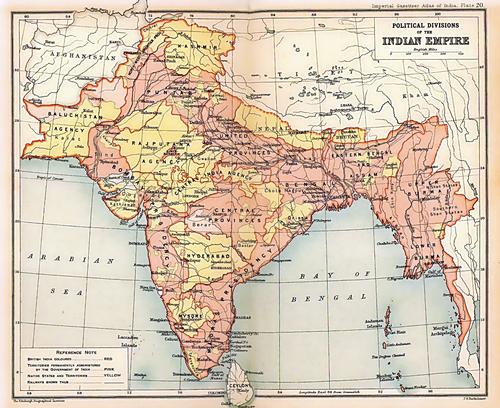 Map of British India in 1909Photo: Public domain
Map of British India in 1909Photo: Public domain
The rise of Ugyen Wangchuck was accompanied by a belief that the dual political system was outdated and ineffective. He replaced his main rival, the ponlop of Paro, and installed a member of the pro-British Dorji family in his place. In addition, the last Zhabdrung died in 1903, and when no reincarnation had appeared in 1906, the civilian government also came under Ugyen Wangchuck's control. Ultimately, the 54th and final Druk Desi was forced to step down, and although reincarnations of Ngawang Namgyal were still being sported, the Zhabdrung system came to an end.
Bhutan becomes a kingdom
In November 1907, Buddhist monks, government officials, and heads of important families gathered to end the moribund 300-year-old dual government system and proclaim a new absolute monarchy. Ugyen Wangchuck was then proclaimed the first Druk Gyalpo (dragon king), which would be the post of king in Western eyes. The British fully agreed with this turn of events. Ugyen Wangchuck ruled from 1907 to 1926 and the Dorji family was appointed heir to the Gongzim office, the main government position.
In 1910 China invaded Tibet and the Dalai Lama was forced to flee to India. But China not only claimed Tibet, but Bhutan, Nepal and Sikkim as well. These developments brought closer togetherness between Great Britain and Bhutan. This was confirmed by the Treaty of Punakha, which increased the donation from 50,000 rupees to 100,000 rupees and the British pledged not to interfere with Bhutan's domestic policy. Bhutan, in turn, promised to listen to Britain's foreign advice. This treaty also caused China to renounce their claims on Bhutan and put an end to the more than 1,000 years of Tibetan-Chinese influence on Bhutan. King Ugyen Wangchuk died in 1926 and was succeeded by his son Jigme Wangchuk, aged 24 at the time, who ruled until 1952.
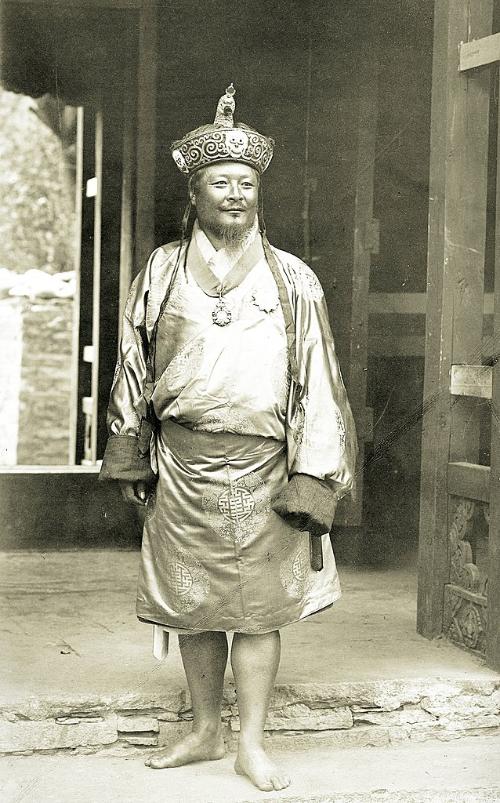 Ugyen Wangchuck, First King of BhutanPhoto: John Claude White in the public domain
Ugyen Wangchuck, First King of BhutanPhoto: John Claude White in the public domain
The reign of the first two kings of Bhutan was marked by political stability and economic progress, despite the reign of Jigme Wangchuck, for example, falling in the midst of the great economic crisis of the 1930s and World War II. Jigme Wangchuck improved the administrative and tax system and brought the entire country under his control.
Bhutan independent
After India's independence on August 15, 1947, the new Indian government recognized Bhutan as an independent country. This was further confirmed by a treaty signed by India and Bhutan in 1949. It was further agreed that India would no longer interfere in Bhutan's internal affairs, and that Bhutan would conform to India's foreign policy. Bhutan also regained some land in the southeast, including Dewangiri, which had been annexed by the British.
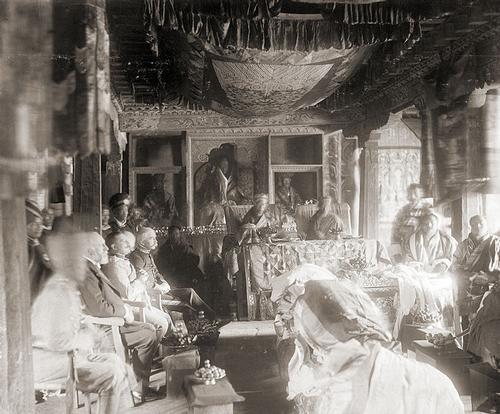
King Jigme Wangchuck died in 1952 and was succeeded by his son Jigme Dorji Wangchuck, who was educated in India and England and was fluent in Tibetan, English and Hindi. In 1958, to strengthen relations with India, he invited the Prime Minister of India, Jawaharlal Nehru, and his daughter Indira Gandhi to visit Bhutan.
In 1959 China took over Tibet, and it became clear to Bhutan that to prevent such a thing from happening, a policy of isolationism would be dangerous and it would be better to join a number of international organizations. In 1961 Bhutan embarked on a process of planned development, and in 1962 it joined the so-called Colombo Plan, an organization that focuses on governmental cooperation for the economic and social development of the Asia-Pacific region. An initial five-year plan was drawn up in 1961, with India helping to finance and build the major Chhukha hydroelectric project in Western Bhutan. Not all Bhutanese agreed with all the changes. There were clashes between rival groups, and on April 5, 1964, a major proponent of change, Prime Minister Jigme Palden Dorji, was assassinated in Phuentsholing. The results achieved by the king's inland policy were impressive: In 1953 he established the National Assembly ('Tshogdu') and wrote a twelve-part legal text. He also abolished slavery, carried out land reforms and established the royal army and a police force. In 1968 the country got a government with ministers for the first time. The judicial system was reformed by separating the judiciary from the executive and a Supreme Court was created. But although he took Bhutan into the modern era, he continued to insist that traditional Bhutanese culture should never be lost.
King Jigme Dorji Wanchuck died at the age of 44 and was succeeded in 1972 by his 16-year-old son Jigme Singye Wangchuck (1955-). He was crowned King of Bhutan on June 2, 1974, but the influence of his mother Kesang Choden (1930-) was still great during the early years of his reign. Important for the development of Bhutan was also the invitation to the international press to attend the coronation. Jigme Singye Wangchuck, like his father, enjoyed education in India and England, but also at the Ugyen Wangchuck Academy in Paro. His wish was to continue his father's modernization policy and make Bhutan economically independent. He also wanted to achieve through all kinds of other measures that his people would become happier, which was expressed by the concept of Gross National Happiness (BNG). This economic independence is not an end in itself, but a means to increase the BNG.
Jigme Singye Wangchuck emphasized the modernization of the education system, health care, rural development and communication. He was also the architect of Bhutanese environmental and conservation policy, in which ecology is considered more important than commercial interests. In 1988 Jigme Singye Wangchuck married four sisters Ashi Dorji Wangmo, Ashi Tshering Pem, Ashi Tshering Yangdon and Ashi Sangay Choedon.
In 1998, he made an important decision, giving up his absolute power and working closely with the National Assembly and the Council of Ministers, and the system of ministerial responsibility was introduced.
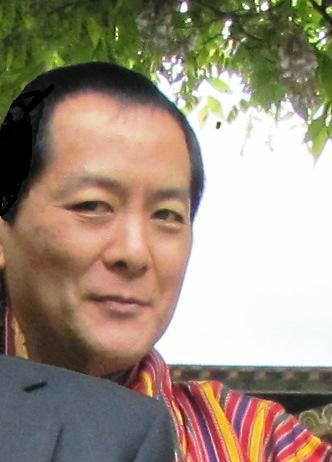 Jigme Dingye Wangchuck, 4th King of BhutanPhoto: Public domain
Jigme Dingye Wangchuck, 4th King of BhutanPhoto: Public domain
In December 2005, Jigme Singye Wangchuck announced his abdication in favor of his eldest son Prince Jigme Khesar Namgyel Wangchuck and resigned on December 14, 2006. He also made sure that Bhutan was changed from absolute monarchy to a democratic constitutional monarchy in July 2008 under the motto 'the monarchy is not the best form of government because a king has become king because of his birthright and not because of his merits'.
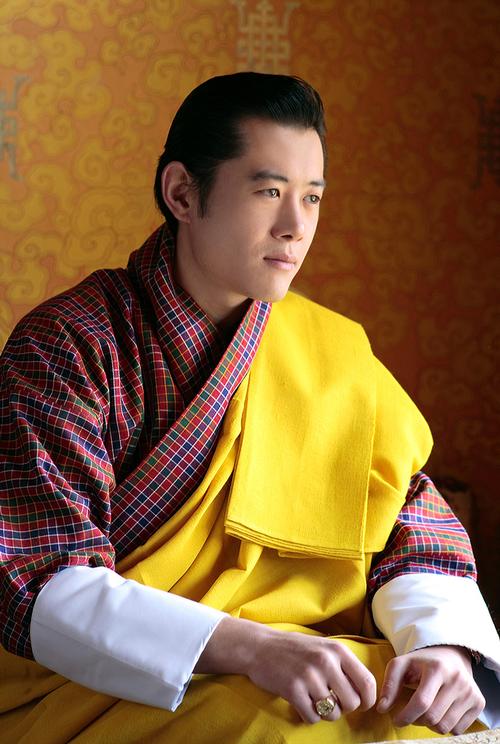 Jigme Khesar Namgyel Wangchuck, BhutanPhoto: Royal Family of Bhutan CC 3.0 Unported no changes made
Jigme Khesar Namgyel Wangchuck, BhutanPhoto: Royal Family of Bhutan CC 3.0 Unported no changes made
In December 2007 elections were held for the 25-member upper house, the Senate as if it were. Elections for the 47-member House of Representatives were held in March 2008. The Bhutan Harmony Party (Druk Phuensum Tshogpa), which is in favor of the monarchy, won very convincingly with 44 seats out of 47. On November 6, 2008, Jigme Khesar Namgyel Wangchuck was crowned the fifth king of Bhutan.
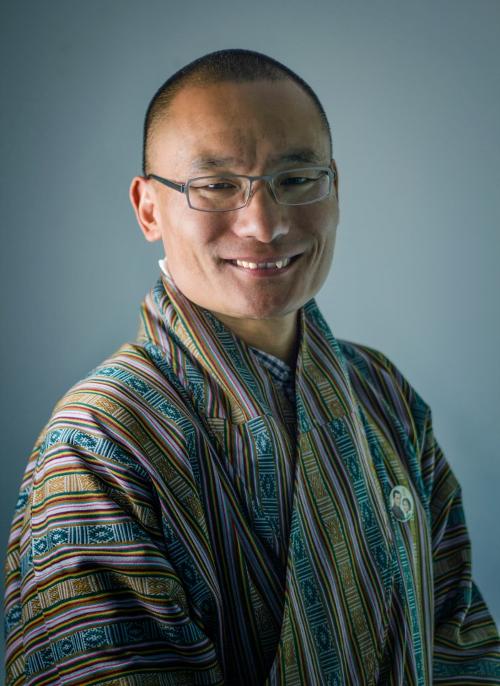 Tsehring Tobgay, Prime Minister of BhutanPhoto:Tsehring Tobgay CC 3.0 Unported no changes made
Tsehring Tobgay, Prime Minister of BhutanPhoto:Tsehring Tobgay CC 3.0 Unported no changes made
In July 2013, the opposition, the People's Democratic Party of Tsehring Tobgay, won the elections and he also became prime minister. In February 2016, the King and Queen announced the birth of Crown Prince Jigme Namgyal Wangchuck. In June 2017, Bhutan protests the construction of a road in a controversial area across China. Tsehring Togbay will remain in power in the November 2018 elections.
Sources
BBC - Country Profiles
Brown, Lindsay / Bhutan
Lonely Planet
CIA - World Factbook
Dorje, Gyurme / Bhutan Handbook
Footprint
Elmar Landeninformatie
Jordans, Bart / Bhutan : a trekker's guide
Cicerone
Pommaret, Françoise / Bhutan : Himalayan mountain kingdom
Odyssey
Te gast in Bhutan
Informatie Verre Reizen
Copyright: Team The World of Info